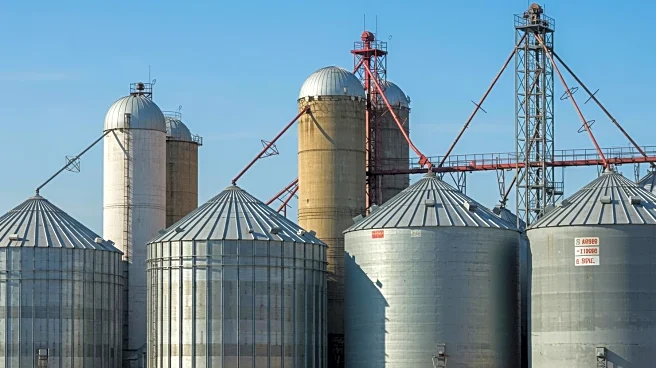What is the story about?
What's Happening?
The grain markets closed with mixed results as traders anticipated a USDA report expected to lean bearish, with higher production and ending stocks for corn and soybeans. December corn closed down 13¾¢ at $3.94½ per bushel, while November soybeans rose 21½¢ to $10.32¾ per bushel. Wheat prices also saw declines, with September CBOT wheat down 10¢ at $5.05 per bushel. The market was influenced by the lack of significant weather threats, although some models predict a hot finish to August, which could impact yields negatively. Livestock markets showed gains, with October live cattle up $2.92 at $229.02 per hundredweight and September feeder cattle up $5.65 at $346.25 per hundredweight. Crude oil prices fell, with September crude oil down 80¢ at $63.16 per barrel.
Why It's Important?
The mixed results in the grain markets reflect the uncertainty surrounding agricultural production forecasts and weather conditions. Higher production and ending stocks could lead to lower prices, affecting farmers' revenues and the agricultural sector's economic stability. The livestock market gains suggest strong demand, which could benefit cattle producers. The decline in crude oil prices may impact energy markets and related industries. These developments are crucial for stakeholders in agriculture, energy, and commodities trading, as they navigate market volatility and adjust strategies accordingly.
What's Next?
Traders and stakeholders will closely monitor the USDA report for insights into production forecasts and stock levels, which could influence future market movements. Weather conditions in August will be critical in determining crop yields, potentially affecting prices further. The livestock market may continue to see fluctuations based on demand and supply dynamics. Energy markets will watch crude oil price trends, which could impact broader economic conditions.
Beyond the Headlines
The anticipated USDA report and weather forecasts highlight the ongoing challenges in agricultural production, including climate variability and market speculation. These factors underscore the importance of adaptive strategies for farmers and traders to mitigate risks. The broader economic implications of commodity price fluctuations may influence policy decisions and investment strategies in agriculture and energy sectors.
AI Generated Content
Do you find this article useful?













